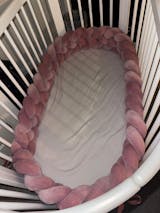Cot bumpers have been debated for years, and if you’re a new parent searching online, you’ll find a mix of warnings, outdated information, and strong opinions. So what’s actually true today? And how do modern braided cot bumpers fit into the conversation?
This guide takes a factual look at the evidence, why the controversy exists, and how parents can use cot bumpers safely – especially when transitioning older babies and toddlers into a bigger sleep space.

Why Cot Bumpers Became Controversial
Traditional cot bumpers – thin, padded panels secured with long fabric ties around the full perimeter of the cot – are where most concerns come from. Years ago, some models were found to pose a risk when:
- ties were excessively long
- padding was overly thick or poorly breathable
- they were used with very young babies unable to roll away
- bumpers were used incorrectly or in unsafe sleep environments
This led UK organisations such as the NHS and The Lullaby Trust to take a cautious stance. Their recommendation is simple: in the absence of an official British Standard specifically for cot bumpers, they take a better-safe-than-sorry approach for young babies.
However, this does not mean all cot bumpers are inherently unsafe – only that old-style designs used in certain ways created risks.

Modern Braided Cot Bumpers Are Different
Today’s braided cot bumpers are not the same product that caused the original controversy. Key differences include:
- No long ties – our designs include short colour-matching ribbons for secure fastening.
- Highly breathable construction – made from cotton velour and hypoallergenic fill, all OEKO-TEX certified.
- Flexible positioning – instead of surrounding the entire cot, many parents use them as partial protection or along one side for toddler beds.
- Not rigid panels – the soft braided structure allows airflow and compresses safely.
Because these designs do not fall under the old “flat tied bumper” category, they are widely used across Europe for older babies and toddlers. Still, UK guidance remains cautious for young infants because there is no formal standard for any bumper type – not because braided bumpers have been proven unsafe.
Is There Evidence of Braided Cot Bumpers Causing Harm?
Currently, there is no UK or EU evidence showing incidents linked to braided cot bumpers. Reported cases that sparked safety concerns historically involved traditional full-panel bumpers, often with thick padding, long ties, or unsafe sleep environments.
What the NHS and Lullaby Trust highlight is the absence of an official testing standard – not evidence of danger from modern breathable designs.

So, Are Cot Bumpers Safe? The Honest Answer
The safest approach is to follow what the UK guidance actually says:
- For young babies (0–12 months): avoid anything soft inside the cot during overnight sleep.
- For older babies and toddlers: cot bumpers can be used safely when positioned correctly and matched to your child’s development.
This is why we recommend our braided cot bumpers for 12 months+, particularly when supporting the transition from cot to toddler bed, or when children start getting limbs stuck between slats.
Safe Ways to Use a Braided Cot Bumper
Here’s how to enjoy the comfort and practicality of a cot bumper without compromising on safety:
✔ Use for 12 months and older
Once babies can roll confidently, move independently, and change positions during sleep, the risks associated with padded items in the cot reduce significantly.
✔ Fasten securely
Use the short ribbons and ensure the bumper is tied tightly so it cannot fall or cover your child’s face.
✔ Keep bedding simple
Even with a bumper, bedding for toddlers should remain breathable: fitted sheet + sleep bag or lightweight duvet if age-appropriate.
✔ Position correctly
Place the bumper along the side where your toddler most often moves, or around the head section to prevent bumps against the wooden slats.
✔ Avoid for co-sleeping
Cot bumpers of any type should never be used in adult beds, sofas, or soft surfaces.
✔ Check regularly
Make sure ties remain secure and the braid stays in its original shape after washing.
Why Toddlers Love Braided Cot Bumpers
Many parents notice that once their little one hits 12–18 months, sleep becomes more active. Toddlers can bump into cot sides, get arms or legs caught between rungs, or feel unsettled in a larger space.
A braided bumper creates:
- a snug, cosy boundary
- a softer surface for wriggly sleepers
- a gentle buffer during the transition to a bigger bed
- a familiar sensory texture that feels calming
Final Thoughts: A Balanced View That Reflects Today’s Reality
Cot bumpers remain controversial mostly because of older classic designs and the lack of an official UK standard, rather than any evidence showing danger from modern breathable braided styles.
Used correctly, for the right age, and with safe sleep habits in place, they can be a practical and comforting addition to your toddler’s sleep space.
As always, follow your instincts, stay informed, and adapt your child’s environment to suit their stage of development.









